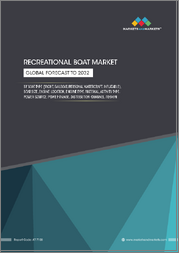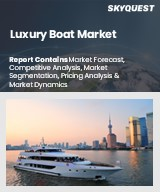
|
시장보고서
상품코드
1622992
세계의 보트 시장 규모 : 추진 시스템별, 재료별, 최종사용자별, 지역별, 범위 및 예측Global Boat Market Size By Propulsion System, By Material, By End-User, By Geographic Scope And Forecast |
||||||
보트 시장 규모와 예측
보트 시장 규모는 2023년에 350억 1,000만 달러로 평가되며, 2024-2030년의 예측 기간 중 CAGR 5.1%로 성장하며, 2030년에는 492억 4,000만 달러에 달할 것으로 예측됩니다. 보트 시장은 레크리에이션 보트, 요트, 범선, 상업용 선박을 포함한 다양한 수상 오토바이의 제조, 판매 및 이용을 둘러싼 전 세계 거래 및 소비 활동을 포괄합니다. 이 시장에는 신규 및 중고 보트뿐만 아니라 유지보수, 수리, 보험, 액세서리와 같은 부수적인 제품 및 서비스도 포함됩니다. 시장은 경제 상황, 소비자 선호도, 기술 발전, 규제 프레임워크, 환경 문제 등의 요인에 영향을 받습니다.
세계 보트 시장 시장 성장 촉진요인
보트 시장 시장 성장 촉진요인은 다양한 요인의 영향을 받습니다.
경제 성장:
보트와 같은 사치품에 대한 소비자의 지출은 일반적으로 GDP 성장률, 고용률, 가처분 소득 수준 등 경제 상황에 따라 좌우됩니다.
이자율 :
이자율 하락은 보트 구매를 위한 대출을 더 쉽게 이용할 수 있게 함으로써 시장 수요를 촉진할 것입니다.
고객의 자신감 :
요트처럼 큰 구매를 할 수 있는 자신감이 있으면 수요가 늘어날 것입니다.
기술의 진보 :
보트의 새로운 디자인, 재료 및 기능은 새로운 고객을 유치하고 현재 소유자가 자신의 보트를 개선하는 계기가 될 수 있습니다.
인구통계:
가처분소득이 많은 노년층과 한창 일할 나이의 젊은 층 등 인구 구성의 변화는 보트의 인기에 영향을 미칠 수 있습니다.
레크리에이션 동향 :
아웃도어 활동과 수상 취미에 대한 관심 증가 등 레크리에이션 취향의 변화가 보트 시장에 영향을 미칠 수 있습니다.
환경 규제 :
환경 규제가 강화됨에 따라 특히 환경 문제가 큰 문제가 되고 있는 지역에서는 전기 보트 및 친환경 보트에 대한 수요가 증가할 수 있습니다.
날씨 :
좋은 날씨가 계속되면 보트 놀이가 활발해져 보트, 액세서리 및 관련 서비스에 대한 수요가 증가 할 수 있습니다.
정부 정책 및 인센티브:
시장 확대는 정부 규제, 보조금 및 기타 보트, 관광 및 해양 분야를 지원하는 구상의 영향을 받을 수 있습니다.
경쟁과 비즈니스 역학 :
보트 사업 시장 확대와 고객 행동은 경쟁사의 행동과 전략, 유통 경로의 변화, 산업 역학의 일반적인 변화에 영향을 받을 수 있습니다.
세계 보트 시장 성장 억제요인
보트 시장에는 몇 가지 요인이 억제요인으로 작용할 수 있습니다.
경기 침체 :
소비 지출 감소는 보트 등 고급품 시장에 영향을 미칠 수 있습니다.
경비 증가:
인건비, 원자재 및 제조 비용 증가로 인해 보트 가격이 상승할 수 있습니다. 그 결과, 보트 구매 가능 가격이 제한되어 수요가 감소할 수 있습니다.
환경에 대한 우려:
환경 문제에 대한 사회적 인식이 높아짐에 따라 법이 더 엄격해지거나 수상 오토바이 사용에 대한 사회적 감시가 강화될 수 있으며, 그 결과 특정 보트 모델과 연료 유형에 대한 수요가 감소할 수 있습니다.
계절성 :
보트 제조업체와 딜러는 따뜻한 계절에 절정에 이르는 보트의 계절적 특성으로 인해 매출과 수익성에 변동이 발생할 수 있습니다.
재정적 제약 :
소비자는 신용 시장의 압박과 금리 상승으로 인해 보트 구매 자금을 조달하기가 더 어려워질 수 있으며, 이는 전반적인 수요를 감소시킬 가능성이 높습니다.
기타 활동과의 충돌:
캠핑, RV 여행, 외국 여행 등 다른 레저 활동과의 경쟁으로 인해 소비자의 지출이 보트에서 멀어질 수 있습니다.
노후화된 인프라:
불충분하거나 노후화된 선착장과 부두는 수로에 대한 접근을 제한하고 보트 이용자의 전반적인 경험에 악영향을 미쳐 보트 소유 의욕을 떨어뜨릴 수 있습니다.
보험료 및 책임 문제:
보험료 상승과 보트 사고로 인한 배상책임 위험에 대한 우려로 인해 구매 희망자가 구매를 꺼리거나 현재 소유자가 보트 활동을 줄이는 원인이 될 수 있습니다.
소비자 취향의 변화:
소형, 연비가 좋은 보트를 선호하는 소비자의 선호도 변화, 소유보다는 체험을 선호하는 소비자의 선호도 변화로 인해 클래식 보트 시장이 영향을 받을 수 있습니다.
지정학적 요인:
중요한 보트 제조 시장과 지역에서 정치적 불안, 무역 마찰, 규제 변경은 공급망을 혼란시키고 가격을 인상하고 고객의 신뢰를 훼손할 수 있으며, 이 모든 것이 전체 시장 성장에 영향을 미칠 수 있습니다.
목차
제1장 서론
- 시장의 정의
- 시장 세분화
- 조사 방법
제2장 개요
- 주요 조사 결과
- 시장 개요
- 시장 하이라이트
제3장 시장 개요
- 시장 규모와 성장의 가능성
- 시장 동향
- 시장 성장 촉진요인
- 시장 성장 억제요인
- 시장 기회
- Porter's Five Forces 분석
제4장 보트 시장 : 추진 시스템별
- 내연 엔진(ICE)
- 전기식
- 세일
제5장 보트 시장 : 재료별
- 유리섬유
- 알루미늄
- 목재
- 복합재
제6장 보트 시장 : 최종사용자별
- 레크레이셔널
- 상업
- 군·정부
제7장 지역별 분석
- 북미
- 미국
- 캐나다
- 멕시코
- 유럽
- 영국
- 독일
- 프랑스
- 이탈리아
- 아시아태평양
- 중국
- 일본
- 인도
- 호주
- 라틴아메리카
- 브라질
- 아르헨티나
- 칠레
- 중동 및 아프리카
- 남아프리카공화국
- 사우디아라비아
- 아랍에미리트
제8장 시장 역학
- 시장 성장 촉진요인
- 시장 성장 억제요인
- 시장 기회
- 시장에 대한 COVID-19의 영향
제9장 경쟁 구도
- 주요 기업
- 시장 점유율 분석
제10장 기업 개요
- Brunswick Corporation
- Groupe Beneteau
- Yamaha Motor Company
- Bombardier Recreational Products
- Azimut Benetti Group
- Malibu Boats
- Polaris Inc.
제11장 시장 전망과 기회
- 신규 기술
- 향후 시장 동향
- 투자 기회
제12장 부록
- 약어 리스트
- 전시와 참고 문헌
Boat Market Size And Forecast
Boat Market size was valued at USD 35.01 Billion in 2023 and is projected to reach USD 49.24 Billion by 2030, growing at a CAGR of 5.1% during the forecast period 2024-2030. The Boat Market encompasses the global trade and consumer activity surrounding the manufacture, sale, and utilization of various watercraft, including but not limited to recreational boats, yachts, sailboats, and commercial vessels. It encompasses both new and pre-owned vessels, as well as ancillary products and services such as maintenance, repair, insurance, and accessories. The market is influenced by factors such as economic conditions, consumer preferences, technological advancements, regulatory frameworks, and environmental concerns.
Global Boat Market Drivers
The market drivers for the Boat Market can be influenced by various factors. These may include:
Economic Growth:
Consumer expenditure on luxuries like boats is usually driven by favorable economic conditions, such as GDP growth, employment rates, and disposable income levels.
Interest rates:
Lower interest rates encourage demand in the market by making financing for boat purchases more accessible.
Customer Confidence:
When people feel confident in their ability to make large purchases, like yachts, demand rises.
Technological Advancements:
New designs, materials, and features for boats can draw in new customers and inspire current owners to make improvements to their craft.
Demographics:
Shifts in the population's composition, like as an elderly population with greater disposable income or a younger group approaching prime earning years, may have an impact on the popularity of boats.
Recreational Trends:
The market for boats may be impacted by changes in recreational tastes, such as a greater interest in outdoor activities or water-based hobbies.
Environmental Regulations:
Tighter environmental laws may increase demand for electric or environmentally friendly boats, especially in areas where environmental issues are major problems.
Weather:
Pleasant weather can encourage more boating and raise the demand for boats, accessories, and associated services.
Government Policies and Incentives:
Market expansion may be impacted by government regulations, grants, or other initiatives that support the boating, tourism, or marine sectors.
Competition and business Dynamics:
Market expansion and customer behavior in the boat business can be impacted by rivals' actions and strategies, modifications to distribution routes, and general shifts in industry dynamics.
Global Boat Market Restraints
Several factors can act as restraints or challenges for the Boat Market. These may include:
Economic Recessions:
Reductions in consumer expenditure can have an effect on the market for upscale goods like boats.
Increasing expenses:
Boat prices may rise as a result of increases in labor, raw material, or production expenses. This could limit boat affordability and reduce demand.
Environmental Concerns:
Raising public knowledge of environmental issues may result in more stringent laws or increased public scrutiny of the use of watercraft, which could lower demand for particular boat models or fuel types.
Seasonality:
Boat manufacturers and dealers may see variations in sales and profitability due to the seasonal nature of boating, which peaks during the warmer months.
Financial Restraints:
Consumers may find it more challenging to obtain financing for boat purchases due to tighter credit markets or higher interest rates, which will likely lower demand overall.
Competition from Other Leisure Activities:
Consumer expenditure may be diverted away from boating by competition from other leisure activities including camping, RV travel, and exotic trips.
Aging Infrastructure:
Inadequate or deteriorating marinas and docks may restrict access to waterways and negatively affect boaters' overall experiences, which may discourage boat ownership.
Insurance Prices and Liability Issues:
Increasing insurance rates and worries about the liability risks arising from boating mishaps may put off prospective purchasers or cause current owners to reduce their boating activities.
Changing Consumer tastes:
The market for classic boat models may be impacted by changes in consumer tastes that favor smaller, more fuel-efficient boats or experiences over ownership.
Geopolitical Factors:
In important boat manufacturing markets or regions, political unrest, trade conflicts, or regulatory changes can disrupt supply chains, raise prices, or erode customer confidence, all of which can have an impact on the growth of the market as a whole.
Global Boat Market Segmentation Analysis
The Global Boat Market is segmented on the basis of Propulsion System, Material, End-User, and Geography.
Boat Market, By Propulsion System
- Internal Combustion Engine (ICE)
- : Traditional engines running on gasoline or diesel fuel.
- Electric
- : Boats powered by electric motors, either solely or as part of a hybrid system.
- Sail
- : Boats utilizing wind power for propulsion, including sailboats and sailing yachts.
Boat Market, By Material
- Fiberglass
- : Most common material for boat construction due to its durability, versatility, and ease of maintenance.
- Aluminum
- : Lightweight and corrosion-resistant, popular for small to medium-sized boats, particularly in freshwater environments.
- Wood
- : Traditional material offering aesthetic appeal, often used in classic or custom-built boats.
- Composite
- : Boats constructed using a combination of materials such as fiberglass, carbon fiber, and epoxy resin, offering a balance of strength, weight, and performance.
Boat Market, By End-User
- Recreational
- : Individuals or families purchasing boats for leisure activities such as cruising, fishing, water sports, and relaxation.
- Commercial
- : Businesses or organizations utilizing boats for commercial purposes such as transportation, tourism, fishing, or water-based services.
- Military and Government
- : Governments, navies, coast guards, and other agencies employing boats for defense, surveillance, law enforcement, search and rescue, and maritime security operations.
Boat Market, By Geography
- North America:
- Market conditions and demand in the United States, Canada, and Mexico.
- Europe:
- Analysis of the Boat Market in European countries.
- Asia-Pacific:
- Focusing on countries like China, India, Japan, South Korea, and others.
- Middle East and Africa:
- Examining market dynamics in the Middle East and African regions.
- Latin America:
- Covering market trends and developments in countries across Latin America.
Key Players
- The major players in the Boat Market are:
- Brunswick Corporation
- Groupe Beneteau
- Yamaha Motor Company
- Bombardier Recreational Products
- Azimut Benetti Group
- Malibu Boats
- Polaris Inc.
TABLE OF CONTENTS
1. Introduction
- Market Definition
- Market Segmentation
- Research Methodology
2. Executive Summary
- Key Findings
- Market Overview
- Market Highlights
3. Market Overview
- Market Size and Growth Potential
- Market Trends
- Market Drivers
- Market Restraints
- Market Opportunities
- Porter's Five Forces Analysis
4. Boat Market, By Propulsion System
- Internal Combustion Engine (ICE)
- Electric
- Sail
5. Boat Market, By Material
- Fiberglass
- Aluminum
- Wood
- Composit
6. Boat Market, By End-User
- Recreational
- Commercial
- Military and Government
7. Regional Analysis
- North America
- United States
- Canada
- Mexico
- Europe
- United Kingdom
- Germany
- France
- Italy
- Asia-Pacific
- China
- Japan
- India
- Australia
- Latin America
- Brazil
- Argentina
- Chile
- Middle East and Africa
- South Africa
- Saudi Arabia
- UAE
8. Market Dynamics
- Market Drivers
- Market Restraints
- Market Opportunities
- Impact of COVID-19 on the Market
9. Competitive Landscape
- Key Players
- Market Share Analysis
10. Company Profiles
- Brunswick Corporation
- Groupe Beneteau
- Yamaha Motor Company
- Bombardier Recreational Products
- Azimut Benetti Group
- Malibu Boats
- Polaris Inc.
11. Market Outlook and Opportunities
- Emerging Technologies
- Future Market Trends
- Investment Opportunities
12. Appendix
- List of Abbreviations
- Sources and References



















